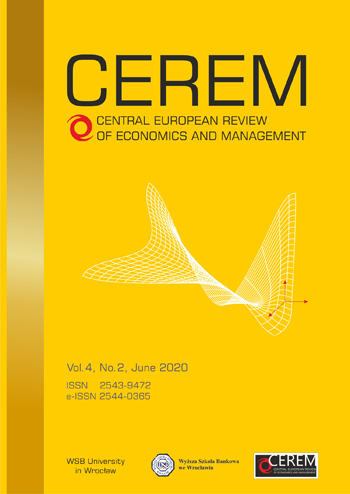Demand deficiency, money velocity and heterogeneity
DOI:
https://doi.org/10.29015/cerem.865Keywords:
Demand Deficiency, Money Velocity, Heterogeneity, Wealth Distribution, Agent Based ModellingAbstract
Aim: Money velocity data for the United States show that there is a decline in all of the broad money aggregates in recent decades. This points to a sustained demand deficiency element. Can consumer heterogeneity be the cause of this declining trend? The aim of this paper is to find an answer for this question.
Design / Research Methods: To achieve our aim we use Agent Based Modelling (ABM). In our model, the agents are heterogeneous consumers with different spending propensities.
Conclusions / findings: We show that heterogeneous consumers with different spending propensities alone puts a downward pressure on money velocity. This pressure is coupled with a sustained worsening in the wealth distribution. We observe that as money accumulates in the hands of agents with the lowest propensity to spend, money velocity keeps declining. This also puts a downward pressure on nominal aggregate demand and hence a deflationary bias on the general price level.
Originality / value of the article: This paper shows that heterogeneity of economic agents should not be ignored and that ABM is a very powerful tool to analyse heterogeneity.
Implications of the research: The implication for policy makers is that the demand deficiency associated with the fall in money velocity will persist until the worsening of wealth dispersion comes to a halt.
References
Arthur W.B. (1991), Designing economic agents that act like human agents. A behavioral approach to bounded rationality, “American Economic Review”, vol. 81, no. 2, pp. 353-359.
Asano Y., Kolp J.J., Heitzig J., Farmer J.D. (2019), Emergent inequality and endogenous dynamics in a simple behavioral economic model, ,,INET Oxford Working Paper”, no. 2019-11.
Axtell R.L., Clinton J.A., Small M.J. (2002), Agent-based modelling and industrial ecology, “Journal of Industrial Ecology”, vol. 5 no. 4, pp. 10-13.
Basci E, Basci S., Lamani A. (2019), Demand Deficiency in G7 Countries [unpublished work].
Benk S., Gillman M., Kejak M. (2010), A banking explanation of the US money velocity: 1919-2004, “Journal of Economic Dynamics and Control”, vol. 34 no. 4, pp. 765-779.
Blundell-Wignall A., Rondoni M., Ziegelschmidt H. (1984), The demand for money and velocity in major OECD countries, OECD Economics and Statistics Department Working Papers, no. 13.
Chowdhury A.R. (1988), Velocity and the variability of money growth. Some international evidence, “Economics Letters”, vol. 27 no. 4, pp. 355-360.
Darrat A.F., Suliman M.O. (1994), Volatility of money growth and the US velocity puzzle. Some further results, “Journal of Economics and Business”, vol. 46, no. 2, pp. 77-88.
Fisher D., Serletis A. (1989), Velocity and the growth of money in United States, 1970-1985, “Journal of Macroeconomics”, vol. 11 no. 3, pp. 323-332.
Friedman M. (1983), Monetary variability. United States and Japan, “Journal of Money, Credit and Banking”, vol. 15 no. 3, pp. 339-343.
Hall T.E., Noble N. (1987), Velocity and variability of monetary growth. Evidence from Granger Causality Tests, “Journal of Money, Credit and Banking”, vol. 19, pp. 112-116.
Karamcheva N. (2016), Trends in family wealth, 1989 to 2013, Congress of the United States Congressional Budget Office Report, https://www.cbo.gov/sites/default/files/114th-congress-2015-2016/reports/51846-familywealth.pdf [25.04.2020].
Kirman A.P. (1992), Whom or what does the representative individual represent?, “Journal of Economic Perspectives”, vol. 6 no. 2, pp. 117-136.
LeBaron B., (2001), A builder’s guide to agent-based financial markets, “Quantitative Finance”, vol. 1 no. 2, pp. 254-261.
Mascaro A., Meltzer A.H. (1983), Long and short term interest rates in a risky world, “Journal of Monetary Economics”, vol. 12 no. 4, pp. 151-200.
Mehra Y.P. (1989), Velocity and the variability of money growth. Evidence from Granger-Causality Test reevaluated, “Journal of Money, Credit, and Banking””, vol. 21, no. 2, pp. 262-266.
Payne J.E. (1992), Velocity and money growth variability. Some further evidence, “International Review of Economics & Finance”, vol. 1 no 2, pp. 189-194.
Payne J.E. (1993), Re-examination of the velocity-money growth variability debate, “Journal of Economics ad Dynamics”, vol. 17 no. 1, pp. 127-133.
Santoni G.J. (1987), Changes in wealth and the money velocity, “Federal Reserve Bank of St. Louis”, March, pp. 16-26.
Zhao W., Lu Y., Feng G. (2019), How many agents are rational in China’s economy? Evidence from a heterogeneous agent-based new Keynesian model, “Computational Economics”, vol. 54, pp. 575-611.
Downloads
Published
Issue
Section
License
The aim of CEREM is to make scientific work available in accordance with the principle of open access. The rules mentioned below are important, as they enable CEREM and its publisher, the WSB Merito University in Wroclaw, to distribute the scientific work to a wide public while complying with specific legal requirements, at the same time protecting the rights of the authors.
The author transfers to the WSB Merito University in Wroclaw, free of charge and without territorial limitations, with all proprietary copyrights to the said piece of work in the understanding of the act of 4th February 1994 on copyrights and derivative rights (Journal of Laws of 1994, no. 24, item 83, as amended) on an exclusivity basis, i.e. the rights to:
1. Make the piece of work in question available via the Digital Library established by the WSB Merito University in Wroclaw.
2. Produce, record and reproduce in multiple copies the piece of work using any techniques whatsoever, including printing, reprography, magnetic recording and digital processing, and particularly its reproduction by recording on CDs and similar data carriers,
3. Use fragments of the piece of work for promotional purposes in publications, promotional materials, the Internet and Intranet type networks managed by the WSB Merito University in Wroclaw.
4. Store the piece of work into computer databases managed by the WSB Merito University in Wroclaw.
5. Copy and reproduce the piece of work using photo-mechanic technologies other than those commonly known at the time of the signature hereof (photocopies, Xerox copies etc.),
6. Process the piece of work, transferring it into an electronic form, and distribute it on the Internet without limitations.


